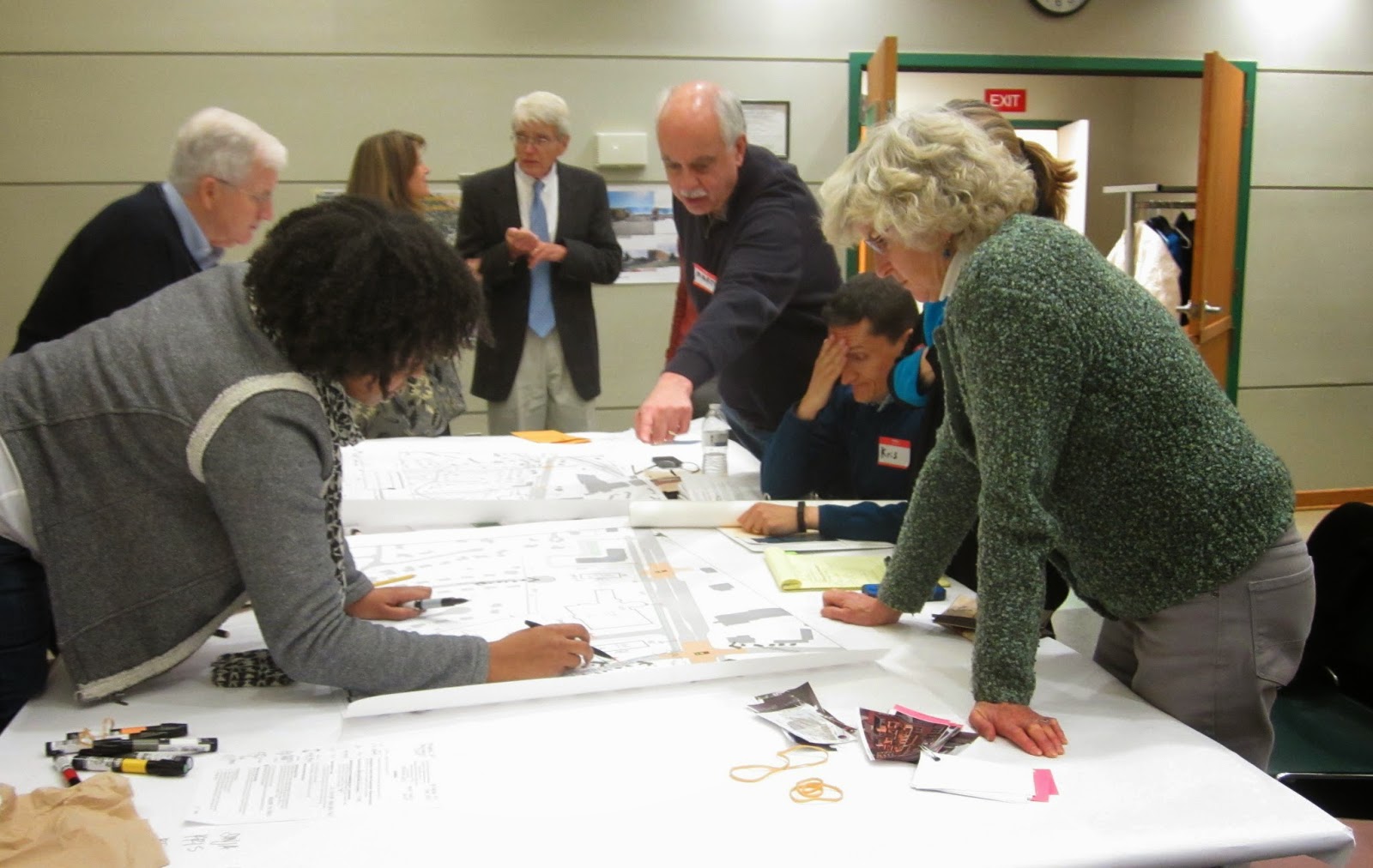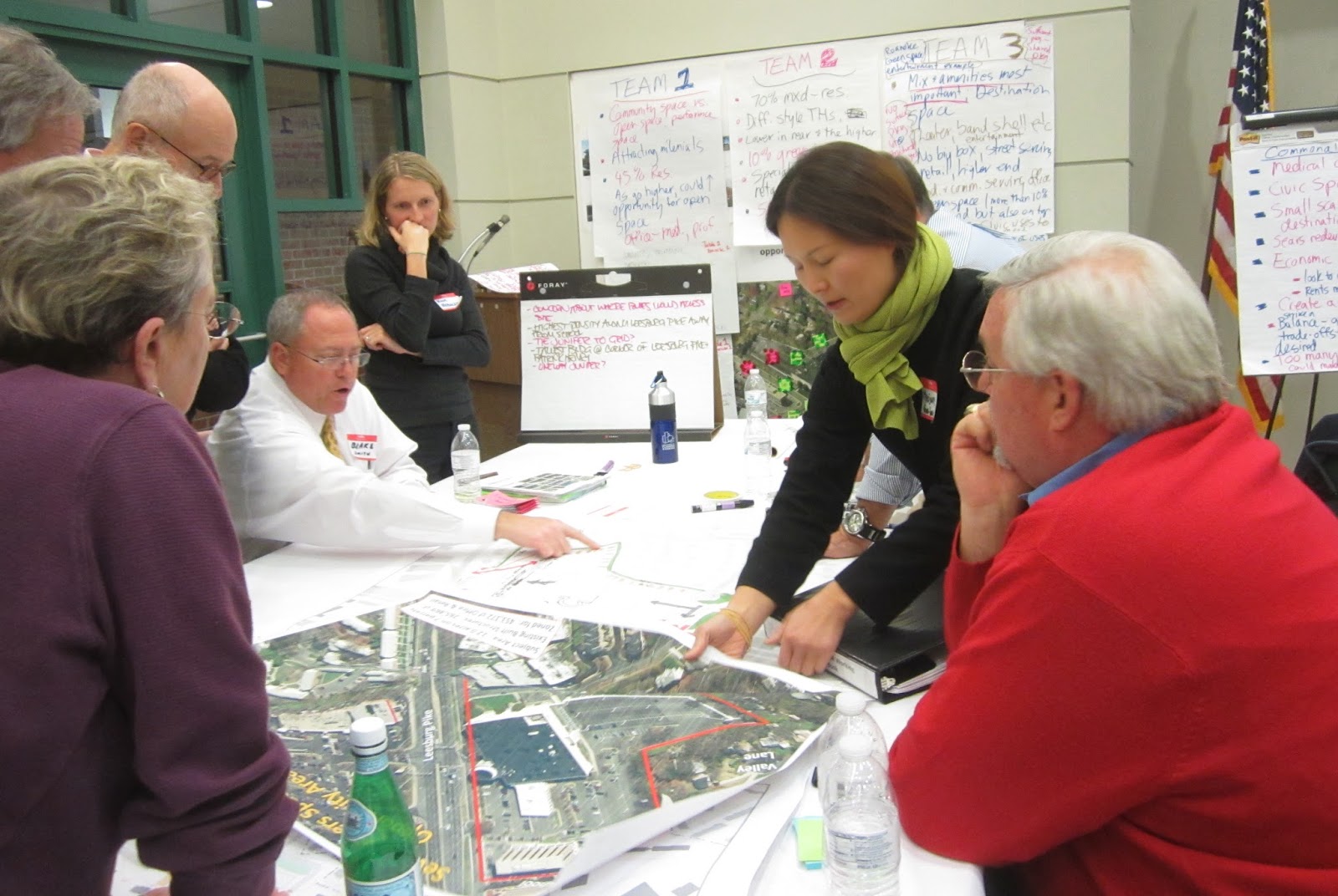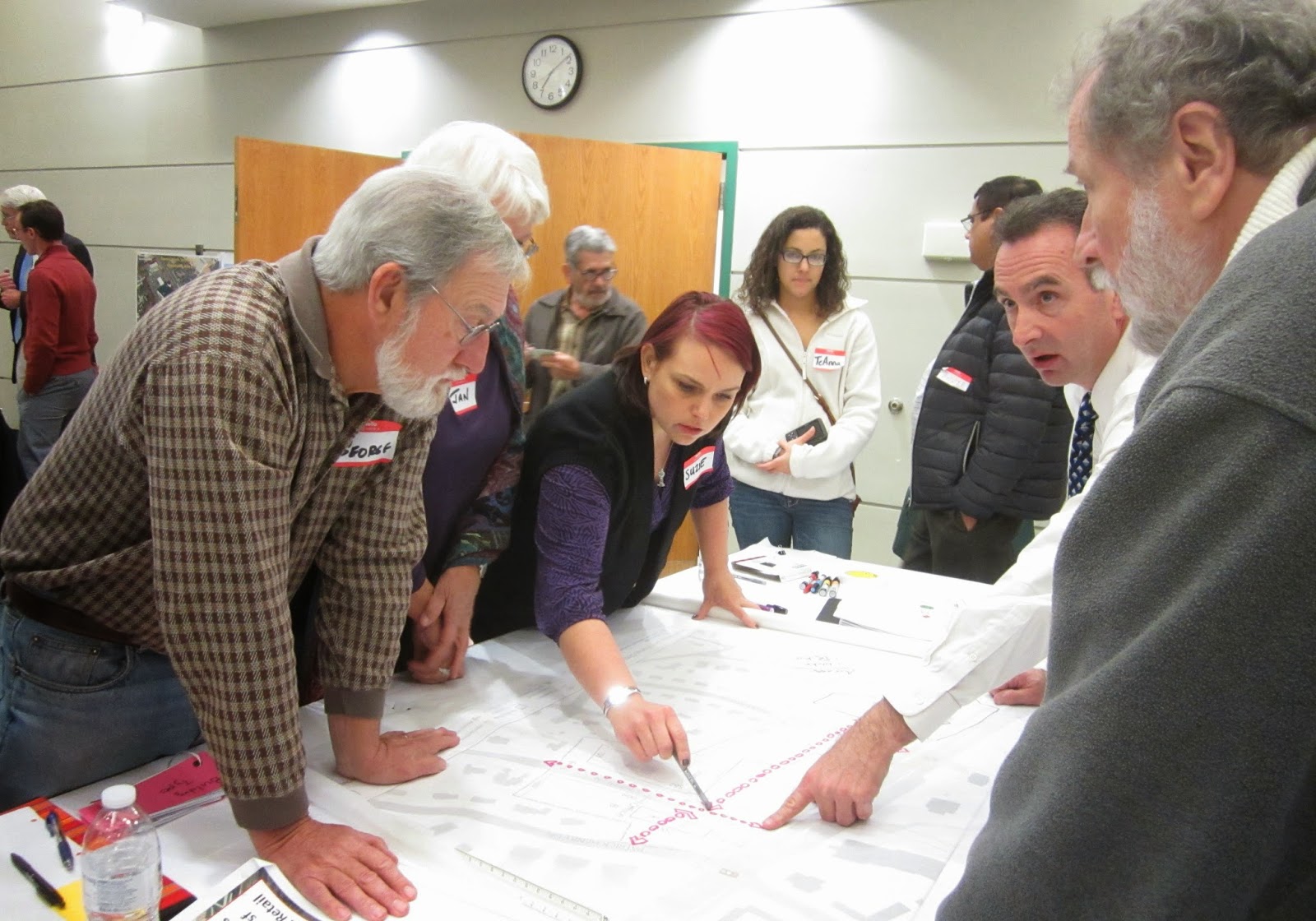Working group on Sears site develops basic design concepts

Members of the Seven Corners Working Group on Opportunity Area C spent most of the afternoon and evening Nov. 19 in a Design Workshop figuring out a vision
for redeveloping the property along Route 7 occupied by Sears and two office
buildings.The working group is continuing the work of the Seven Corners Task Force on Land Use and Transportation.
for redeveloping the property along Route 7 occupied by Sears and two office
buildings.The working group is continuing the work of the Seven Corners Task Force on Land Use and Transportation.
The Design Workshop started with a presentation on the
impact of demographic and transportation trends and a couple of preliminary activities led by Joanne Fiebe of the Fairfax County Office of Community Revitalization (OCR) calling for participants to identify opportunities and constraints in the Sears site and their communities’ top priorities for redevelopment.
Committee members, augmented by a few additional local
residents, then spent several hours in one of three groups hashing out general concepts on what types of uses they would
like to see on that property. After presenting their ideas, the three groups reconvened to determine where the different elements should go.
residents, then spent several hours in one of three groups hashing out general concepts on what types of uses they would
like to see on that property. After presenting their ideas, the three groups reconvened to determine where the different elements should go.
One group proposed three-quarter of the land be devoted to
mixed residential uses, including housing for seniors, with the rest used for a
mix of community-serving retail and specialized medical and other offices. That group
talked about having connected walkways, fountains, and limited access to Route
7.
mixed residential uses, including housing for seniors, with the rest used for a
mix of community-serving retail and specialized medical and other offices. That group
talked about having connected walkways, fountains, and limited access to Route
7.
Another group called for 45 percent residential, 20 percent
retail, 20 percent office, and 5 percent for community uses. That group
proposed retaining the Sears building’s iconic round tower, having a park in
between the site and Bailey’s Upper Elementary School, closing off Juniper Lane,
including housing for seniors, which wouldn’t overburden the schools, and having
the tallest buildings – four to six stories – along Route 7 with townhouses or
single-family houses at the back of the property.
retail, 20 percent office, and 5 percent for community uses. That group
proposed retaining the Sears building’s iconic round tower, having a park in
between the site and Bailey’s Upper Elementary School, closing off Juniper Lane,
including housing for seniors, which wouldn’t overburden the schools, and having
the tallest buildings – four to six stories – along Route 7 with townhouses or
single-family houses at the back of the property.
That group also felt it was important to address the
concerns raised by community members, including how the development and
transportation improvements should be phased, drainage, and school
overcrowding.
concerns raised by community members, including how the development and
transportation improvements should be phased, drainage, and school
overcrowding.

The third group proposed 50 percent residential; 15 percent
for entertainment, retail, and restaurants; 10 percent for community-serving
offices, like attorneys and accountants; and 10 percent for green, open space,
including a park between the site and the school. They also called for six to eight-story
buildings along Route 7 with retail facing the street, townhouses at the rear
of the site, an athletic field, and repurposing or rebuilding the Sears tower.
for entertainment, retail, and restaurants; 10 percent for community-serving
offices, like attorneys and accountants; and 10 percent for green, open space,
including a park between the site and the school. They also called for six to eight-story
buildings along Route 7 with retail facing the street, townhouses at the rear
of the site, an athletic field, and repurposing or rebuilding the Sears tower.
Among the commonalities in all three concepts noted by
Fiebe: a wider mix of uses than proposed by the Seven Corners Task Force, space
for civic gatherings, medical offices, community-focused retail, green space,
public amenities, an improved streetscape along Route 7, and improved walkability. Surprisingly, all three groups came up with fairly high-density projects with lots of housing.
Fiebe: a wider mix of uses than proposed by the Seven Corners Task Force, space
for civic gatherings, medical offices, community-focused retail, green space,
public amenities, an improved streetscape along Route 7, and improved walkability. Surprisingly, all three groups came up with fairly high-density projects with lots of housing.
OCR staff will refine the work of the three groups and
fill in some details. The public will get a chance to comment on the three concepts at an
open house scheduled for Dec. 9, 3-9 p.m. at the Willston Center.
fill in some details. The public will get a chance to comment on the three concepts at an
open house scheduled for Dec. 9, 3-9 p.m. at the Willston Center.
The working group’s next meeting is Dec. 2, 7-9 p.m., at the Mason Government
Center. It will have three more meetings in 2015: Jan. 7, Jan. 20, and Feb. 5.
Center. It will have three more meetings in 2015: Jan. 7, Jan. 20, and Feb. 5.

The Design Workshop opened with a review of the impact of
population and transportation trends on land use and economic development by Ian
Banks of Nelson Nygaard Consulting Associates. Among the relevant statistics
cited:
population and transportation trends on land use and economic development by Ian
Banks of Nelson Nygaard Consulting Associates. Among the relevant statistics
cited:
- One-third to one-fifth of urbanized land is taken up by public
streets and rights of way. - The Ballston-Rosslyn corridor is only 5 percent of the land
in Arlington County but generates 33 percent of the county’s revenue. - 70 percent of all household trips are five miles or less,
and 83 percent of those trips are by automobile. - 69 percent of Americans are overweight and 35 percent of that
group is clinically obese. - The average cost of owning a car is about $9,000 a year.
- Two-thirds of millennials would rather give up their car
than their computer or phone. - One-quarter of millennials do not have a driver’s license,
and 88 percent want to live in an urban setting. - The period from thinking about a project to completing it is
about 10 years. - In six years, autonomous vehicles will be available.
- A grid of narrower streets is more likely to encourage
economic development than a major road with multiple lanes. - Reducing the speed limit from 45 to 35 mph or from 35 to 25
mph leads to safer, more livable communities.


"Surprisingly, all three groups came up with fairly high-density projects with lots of housing."
It seems the participants forgot that the community had enormous concerns about high density housing at that location and that is the reason why they are sitting on this special working group further exploring the redevelopment options at Sears.
I love your comment. Clearly what we need on this site is a park with many bocce ball courts for the elementary schools kids to move and stay fit, while they digest their daily ration of carrots and kale.
Where is the bike path? or a walkway connecting thru this area?
I heartily endorse bike paths, sidewalks and other pedestrian-friendly development. Europe is WAY ahead of us on public transportation, green space, bike paths, and energy efficiency. We should look to their infrastructure as a model.